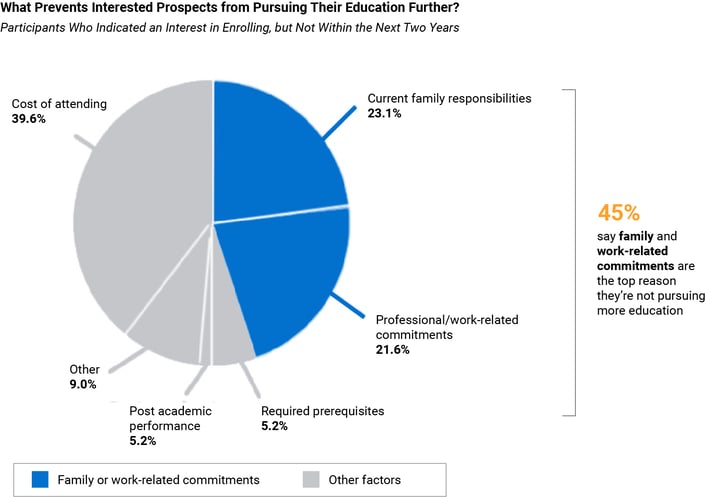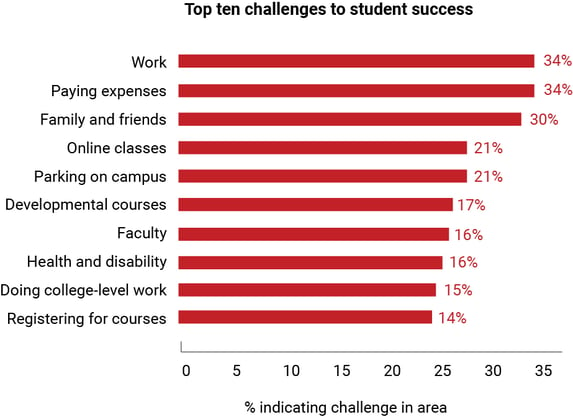
The way that colleges determine who can and cannot enroll varies considerably from school to school. Even prior to the pandemic, many schools were either not requiring or not weighing very heavily results from standardized tests such as the ACT or SAT. The original intention of the tests was to provide an unbiased, standardized comparison of students' academic abilities.
But over time, the assessments came under criticism as they posed challenges to students who suffer from test anxiety, can’t afford or don't have access to testing, or were impacted by bias in question-wording. Because of the level of concern over inequity due to these emotional, ethnic, and/or economic factors, many schools changed their position on the requirement or use of these standardized exams that utilized cognitive factors as a gatekeeper to admissions. Then the pandemic dramatically impacted the level of access that learners have to education, and as such, this further fueled the process of change in admissions practices at many schools.
Take a look at this video and blog summary to learn how your institution can use non-cognitive data to support your students and better evaluate their learner readiness through SmarterMeasure.
Don't want to watch the video? No problem! Keep scrolling to read the video summary.
Video Summary
ACT and SAT Requirements
According to FairTest.org, over 1,400 four-year colleges and universities will not require ACT or SAT scores for Fall 2022 entry. That is more than 60% of the 2,330 undergraduate institutions in the United States. A listing of these institutions is also provided by CollegeLifeToday.com.
Bob Schaeffer, Executive Director of FairTest.org stated, “Last year’s sharp spike of admissions exam suspensions was not a one-time phenomenon. Schools that waived ACT/SAT score requirements during the pandemic generally saw more applicants, better academically qualified academics, and more diversity of all sorts. Now, most are extending those policies for at least another year.” The organization also states that “many published studies are finding that students admitted without test scores do as well academically as peers who submitted ACT/SAT results.”
Why Readiness Matters
This shift to a less restrictive admissions process is certainly promising as it may increase higher educational opportunities for many learners. The elimination of the barrier of having to attain a certain score on a test which uses cognitive factors may prompt many hesitant students to enroll. However, with that said, even in a more open admissions environment, the reality remains that students do have varying degrees of readiness from a cognitive and non-cognitive perspective. So, how can schools identify and support enrolled learners who may be at-risk due to low levels of readiness?
Why do students drop out?
A parallel construct to college admissions is college student retention. The Gates Foundation conducted a comprehensive study to determine why college students drop out. The top five reasons were:
- Conflicts with work schedule
- Affordability of tuition
- Lack of support from family – financial and practical support
- Lack of belief that a college degree is valuable
- Lack of discipline – too much socializing, not enough studying
It is worthy of note that “not being smart enough to do the work” was not one of the dominant factors leading to dropping out of college.
Why do some students not enroll?
In a similar study, the Education Advisory Board surveyed 1,000 college students to identify new data points that enhance our understanding of why some adult learners choose to enroll, why some don't. Below are the results of that study.

Again, the list is dominated by non-cognitive factors such as cost, family responsibilities, and work commitments.
Changes While Enrolled
North Carolina State University asked students who were enrolled in online courses to rank their challenges. The results were very similar with work, expenses, and family topping the list.

So, if non-cognitive factors are the reason why many students do not enroll, they are the source of challenges during enrollment, and finally, they are the reasons why many students drop out, then it is paramount that schools measure these factors and respond to students as a useful student service.
Measuring Non-Cognitive Readiness
At SmarterServices, we consider it a good practice, especially in an environment that eliminates or de-emphasizes standardized cognitive exams in admissions, to use an assessment that quantifies levels of non-cognitive readiness. This should not be done as a gatekeeper, but as a student services tool to increase the student’s level of awareness of their strengths and opportunities for improvement coupled with equipping them with resources for support.
But can grit be measured? While it may seem that quantifying non-cognitive constructs is like trying to nail Jello to the wall, there is an assessment that has effectively done this for almost 20 years for about 6 million students. That assessment is the SmarterMeasure Learning Readiness Indicator.
SmarterMeasure Scales and Subscales
Internal Attributes and Preferences
The assessment starts out looking at the student internally. We call this section, Individual Attributes. It measures things like motivation, control over procrastination, willingness to ask for help, and locus of control. While we're looking at the student internally, we also identify their dominant learning style or learning preference. It is based on the multiple intelligences model and determines whether the student is social, solitary, visual, verbal, etc.
External Life Factors
After looking at the student internally, we look at the student externally in a scale called Life Factors. This scale measures things such as availability of time, support from family and employers, general health, and finances. So, it is really an environmental scan of what is going on in the student's life.
Skills
Next, we measure several skills of the student. We measure their on-screen reading rate and recall. We measure their technical skills through a Technical Competency and Technical Knowledge scale. We also have a scale specific to learning management system competency, The final skill that is measured is keyboarding rate and accuracy.
Additional Attributes
You may notice that in addition to measuring these non-cognitive skills, we also offer two scales that measure levels of math and writing readiness. These scales are not intended to be as diagnostic nor prescriptive as a placement exam, but many schools use them to inform student’s decisions about course selection and the need for tutoring services.
Our math and writing readiness scales are each thirty-item instruments that pull from a ninety-item pool. Completion time and the level of exam anxiety is typically much less than that experienced by students as they take larger cognitive assessments.
Start Supporting Your Students Through the use of Non-Cognitive Data
So, if your institution is deemphasizing the use of cognitive factors measured by standardized exams, we consider it a positive and appropriate strategy to use SmarterMeasure to increase a student’s level of awareness about their levels of readiness. We recommend positioning the assessment in the student experience as a student support resource for enrolled students, not a gatekeeper of prospective students. Also, to help enrolled students understand their level of readiness for a college-level math and/or writing course, we recommend our assessments as a low-stakes diagnostic. The results of these cognitive assessments can be useful to academic advisors as they may recommend tutoring services.
For more information about SmarterMeasure or to request a demo, click here and we'd be happy to help.
Otherwise, be sure to subscribe to our blog for more great educational blogs, videos, and tips to help your students succeed.




.jpg)


